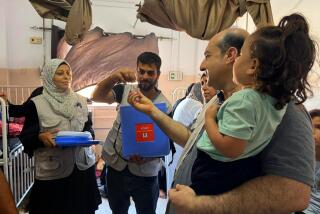Salkâs Vaccine Freed Scared Nation From Terror of Polio 30 Years Ago
PITTSBURGH â Summer after summer, as certain as school vacations and sandlot baseball, the specter of polio terrified the nation.
The victims were both young and adult, but most often they were defenseless children. Infantile paralysis struck regardless of race or riches, suburb or city.
Thousands died each year. Tens of thousands were left crippled.
Parents barred children from swimming pools, theaters and other public places where the disease was thought to fester.
The phantom of contagion postponed summer events such as family reunions and business conventions.
Communities Quarantined
Entire communities--like Florence, S.C., in July, 1948,--were quarantined when an epidemic hit. Emergency teams of polio experts and tons of iron lungs were rushed in. Day after sweltering day, as the cursed season dragged on, newspaper headlines kept track of the toll.
âIt was sheer hell,â recalls Alberta Kruger, 54, a nurse in the isolated polio ward of Pittsburghâs Municipal Hospital during the early 1950s.
Then, 30 years ago Friday, came the word: The Salk vaccine is safe, effective and potent.
For a quiet, young scientist named Dr. Jonas E. Salk, that meant vindication and fame. The world had an answer to polio.
The announcement was made on the 10th anniversary of President Franklin D. Rooseveltâs death, culminating a crusade he had led from his wheelchair, the March of Dimes. The date was April 12, 1955.
âDialogue With Natureâ
In a recent telephone interview from The Salk Institute for Biological Studies in La Jolla, Calif., Salk said, âI entered into a dialogue with nature and asked, âIs it possible?â I put it to nature in the form of an experiment and nature replied, under these conditions, yes it would work.â
Elaine Whitelaw, 70, a director for the National Foundation for Infantile Paralysis, now known as the March of Dimes Birth Defects Foundation, called it the first âpeopleâs victory over a disease.â
The chain of research was long and distinguished. Earlier, a team of Nobel Prize-winning scientists had learned how to grow viruses in tissue culture. And the race was on to develop an effective vaccine that could convince the body to produce antibodies against polio.
Salkâs work began in earnest in a University of Pittsburgh laboratory in the early 1950s. But the basis for the breakthrough had begun to ferment many years before.
The eldest son of a New York City garment manufacturer, Salk graduated from high school at age 15 intending to become a lawyer. In college, however, he opted for medical school and scientific research.
Influenza Vaccine
In 1942, following a fellowship in protein chemistry and an internship at New Yorkâs Mount Sinai Hospital, Salk joined the University of Michigan and began working on an influenza vaccine to protect the country against a wartime epidemic.
Five years later, Salk agreed to head a virus research program at the University of Pittsburghâs fledgling medical school. There he was asked to conduct part of a polio virus classification program for the National Foundation for Infantile Paralysis.
In 1952, the worst year of the disease on record, 57,900 cases of paralytic polio were reported in the United States, afflicting one in every 3,000 persons, according to the federal Centers for Disease Control. The mortality rate hovered between 5% and 10%.
Among those stricken in the early 1950s were Bill Kirkpatrick, the 16-year-old son of a Pittsburgh corporate executive, and Jimmy Sarkett, the 10-year-old son of a Daisytown, Pa., coal miner.
Sudden Onset of Disease
Kirkpatrick was on his way home from his grandmotherâs house, looking forward to starting school and trying out for the football team, when his neck became stiff and his throat began to hurt. Within hours, he could barely breathe or move.
For Sarkett, it was just as sudden.
Both boys were rushed to Pittsburghâs Municipal Hospital and isolated on the third floor with other polio patients, tottering between life and death.
No one, not even his parents, mentioned the word âpolioâ to the young Kirkpatrick.
âI saw the iron lungs. And I knew,â he recalls.
âI remember excruciating pain . . . delirium, fever,â Sarkett recalls.
Salk, Team at Work
Just two floors below, meanwhile, Salk and his team of researchers were working frantically to come up with a vaccine.
Their efforts were boosted by Sarkett, whose particular type of virus became the third and final strain incorporated into Salkâs vaccine.
Salk experimented with strains of both live and killed virus, testing his results on animals. He finally decided on killed virus for his vaccine, a move that dismayed many virologists, including Dr. Albert Sabin, who preferred waiting for the development of a more potent and longer-lasting product made of tamed live virus.
In 1952, a confident Salk began testing his vaccine on polio patients at the D.T. Watson Rehabilitation Hospital, a home for crippled children in nearby Sewickley.
The first to volunteer for the experiment was Kirkpatrick, by then recovering slowly with the aid of steel braces and crutches. More than 40 other youngsters bared their arms.
Antibody Killed Viruses
Blood samples taken from the vaccinated were deposited in tissue cultures containing polio viruses. To Salkâs jubilation, the vaccination-produced antibody killed the viruses and the cells continued to grow.
In 1953, Salk extended his studies to healthy children in Pittsburgh, including his own three sons.
âMy confidence was based on solid evidence,â he says.
Encouraged by Salkâs results, the National Foundation for Infantile Paralysis began planning a $7.5-million campaign to inoculate more than 1.8 million children in 44 states.
Despite continued protest from live-virus proponents, the program was approved by a panel of health experts on April 25, 1954. The next day, the first shot of the cherry-color vaccine was administered in Fairfax County, Va. That was the start of the largest clinical experiment in the history of medicine.
Data Collected
For much of the next year, doctors, nurses, teachers, principals and parents kept tabs on the children, those who either received the vaccine or the placebo. The data was forwarded to Dr. Thomas Francis Jr. at the University of Michigan, who analyzed the results.
Then, on April 12, more than 500 scientists and reporters gathered in Ann Arbor to hear the news.
âThe vaccine works,â Francis announced. âIt is safe, effective and potent.â
In a celebration usually reserved for the ends of wars, whistles blew and bells pealed.
The atmosphere was somewhat more subdued in Pittsburgh.
âAll the kids had already had the vaccine. It was just an ordinary day . . . I donât remember any big deal,â recalls Dr. Robert Nix, 73, a pediatrician at D.T. Watson who assisted Salk in the experimental vaccinations.
Salk Called a Hero
To the public, Salk was the hero. To many of his colleagues, however, he was not.
âSalk was not very generous (that day) to those who had worked with him,â says Dr. Julius Youngner, 64, Salkâs senior research associate. âThe campaign to deify him had begun.â
During the next few days, carloads of telegrams poured into Ann Arbor from all over the world. Hundreds wanted Salk for speeches. Hundreds of others wanted him for awards. Calls came from Hollywood; Marlon Brando had agreed to play the film role.
All he wanted, Salk told reporters again and again, was a chance to return to his laboratory and get on with his work.
Whether or not they approved of the clamor, scientists agreed it was the most dramatic breakthrough of the 20th Century.
âMomentous Occasionâ
âWe were able to produce a vaccine and prevent paralysis in young children,â says Dr. Bruce Dan, 38, senior editor of the Journal of the American Medical Assn. âThat was a momentous occasion . . . Now we had a whole technology of vaccines to prevent people from getting viral infections.â
The number of paralytic polio cases tumbled to 15,100 in 1956, down 48% from the previous year. The decline continued into the 1960s, as a live-virus, oral vaccine developed by Sabin was being tested in the Soviet Union.
By the time the Sabin vaccine was licensed in the United States in the early 1960s and recommended for general use, âpolio was well under control,â according to Youngner.
In 1983, the latest year for which figures are available, only 12 cases of paralytic polio were reported in the United States, all of them related to the Sabin vaccine, according to Dr. Ben Nkowane, an epidemiologist for the Centers for Disease Control.
Because of the live virus which goes into making the Sabin vaccine, one of about every 3.2 million doses results in paralytic polio, says Dr. Edward Brink, also a CDC epidemiologist. No risk exists with a killed-virus vaccine.
New Vaccines Evaluated
Federal health agencies continue to evaluate new vaccines.
âWe still feel that for the United States, the oral polio vaccine is still the one to go with,â in part, because of the ease and simplicity in administering it, Brink says.
âPeople donât like needles,â Youngner explains.
Salk and Sabin currently are focusing their efforts--differing though they may be--on curbing polio worldwide.
More than 32,000 cases of paralytic polio were reported to the World Health Organization in 1983, more than half of them in Southeast Asia. Most health experts consider the figures to be âgross underestimatesâ since many countries simply fail to report.
Salk Refines Vaccine
At his California institute, which he founded in 1963 on a bluff overlooking the Pacific Ocean, Salk continues to refine his vaccine and campaign for its use worldwide while pursuing a philosophical study of human nature. His vaccine is used primarily in The Netherlands.
The 78-year-old Sabin, meanwhile, is working as a senior consultant for the National Institutes of Healthâs Fogarty International Center in Bethesda, Md., devising ways to improve the administration of vaccinations in developing nations.
The fight against polio, for them both, rages on.
âClearly, the business is unfinished,â Salk says.
âIn the early part of my life, where there was a will there was a way. I have now come to realize where there is a way, there is not always a will.â






